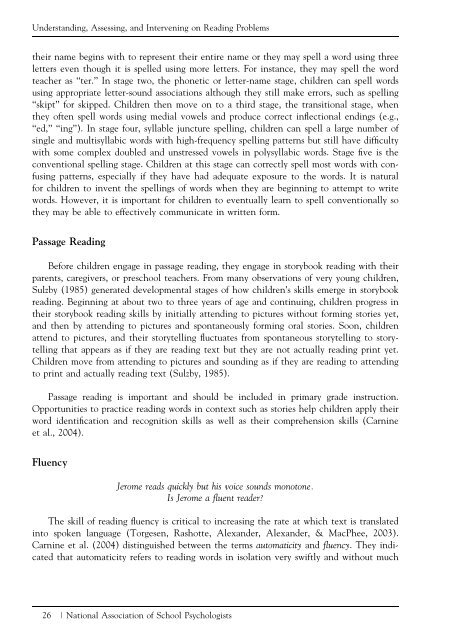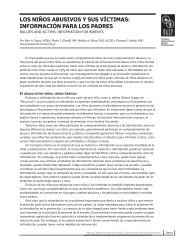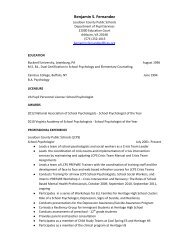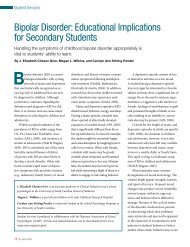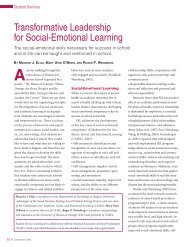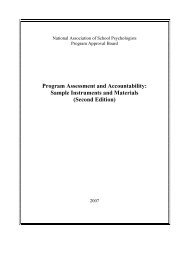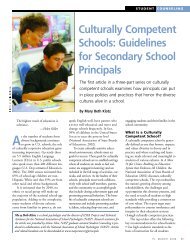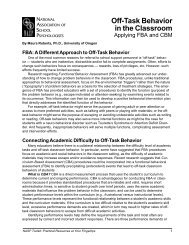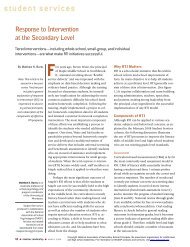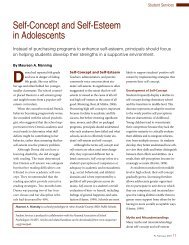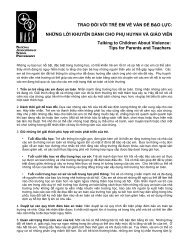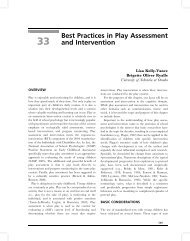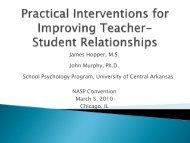Chapter 1 - National Association of School Psychologists
Chapter 1 - National Association of School Psychologists
Chapter 1 - National Association of School Psychologists
You also want an ePaper? Increase the reach of your titles
YUMPU automatically turns print PDFs into web optimized ePapers that Google loves.
Understanding, Assessing, and Intervening on Reading Problems<br />
their name begins with to represent their entire name or they may spell a word using three<br />
letters even though it is spelled using more letters. For instance, they may spell the word<br />
teacher as ‘‘ter.’’ In stage two, the phonetic or letter-name stage, children can spell words<br />
using appropriate letter-sound associations although they still make errors, such as spelling<br />
‘‘skipt’’ for skipped. Children then move on to a third stage, the transitional stage, when<br />
they <strong>of</strong>ten spell words using medial vowels and produce correct inflectional endings (e.g.,<br />
‘‘ed,’’ ‘‘ing’’). In stage four, syllable juncture spelling, children can spell a large number <strong>of</strong><br />
single and multisyllabic words with high-frequency spelling patterns but still have difficulty<br />
with some complex doubled and unstressed vowels in polysyllabic words. Stage five is the<br />
conventional spelling stage. Children at this stage can correctly spell most words with confusing<br />
patterns, especially if they have had adequate exposure to the words. It is natural<br />
for children to invent the spellings <strong>of</strong> words when they are beginning to attempt to write<br />
words. However, it is important for children to eventually learn to spell conventionally so<br />
they may be able to effectively communicate in written form.<br />
Passage Reading<br />
Before children engage in passage reading, they engage in storybook reading with their<br />
parents, caregivers, or preschool teachers. From many observations <strong>of</strong> very young children,<br />
Sulzby (1985) generated developmental stages <strong>of</strong> how children’s skills emerge in storybook<br />
reading. Beginning at about two to three years <strong>of</strong> age and continuing, children progress in<br />
their storybook reading skills by initially attending to pictures without forming stories yet,<br />
and then by attending to pictures and spontaneously forming oral stories. Soon, children<br />
attend to pictures, and their storytelling fluctuates from spontaneous storytelling to storytelling<br />
that appears as if they are reading text but they are not actually reading print yet.<br />
Children move from attending to pictures and sounding as if they are reading to attending<br />
to print and actually reading text (Sulzby, 1985).<br />
Passage reading is important and should be included in primary grade instruction.<br />
Opportunities to practice reading words in context such as stories help children apply their<br />
word identification and recognition skills as well as their comprehension skills (Carnine<br />
et al., 2004).<br />
Fluency<br />
Jerome reads quickly but his voice sounds monotone.<br />
Is Jerome a fluent reader?<br />
The skill <strong>of</strong> reading fluency is critical to increasing the rate at which text is translated<br />
into spoken language (Torgesen, Rashotte, Alexander, Alexander, & MacPhee, 2003).<br />
Carnine et al. (2004) distinguished between the terms automaticity and fluency. They indicated<br />
that automaticity refers to reading words in isolation very swiftly and without much<br />
26 <strong>National</strong> <strong>Association</strong> <strong>of</strong> <strong>School</strong> <strong>Psychologists</strong>


